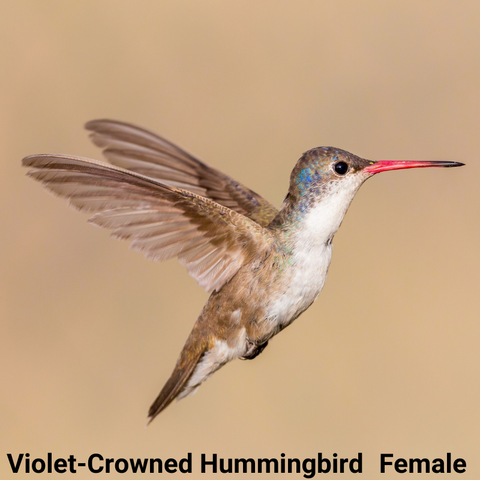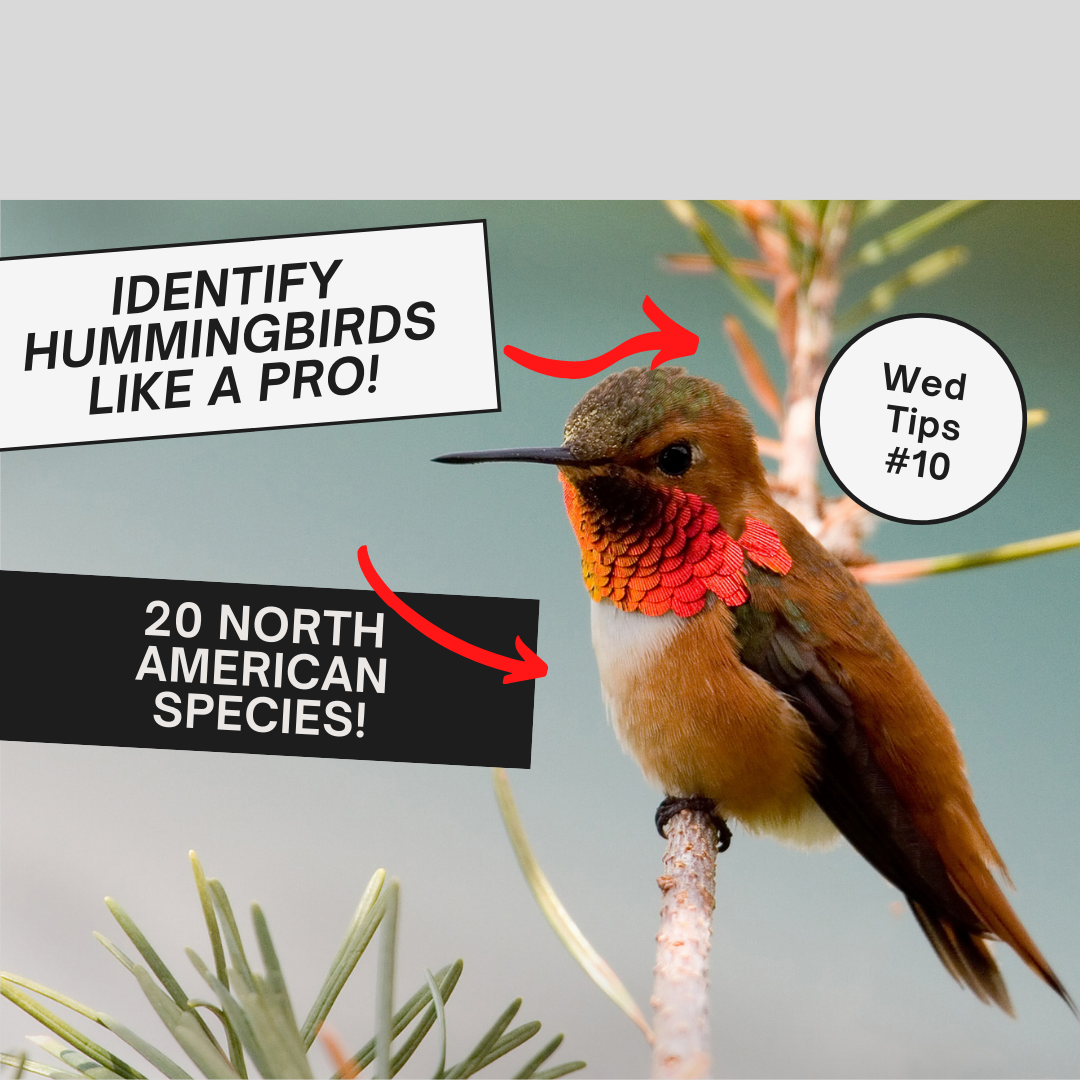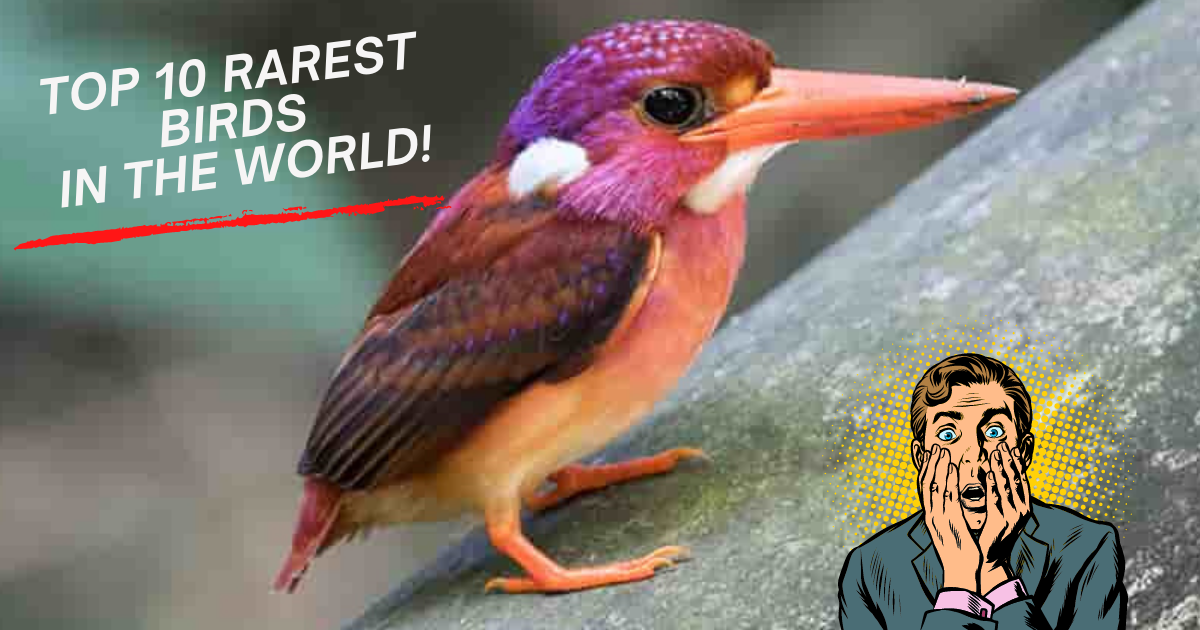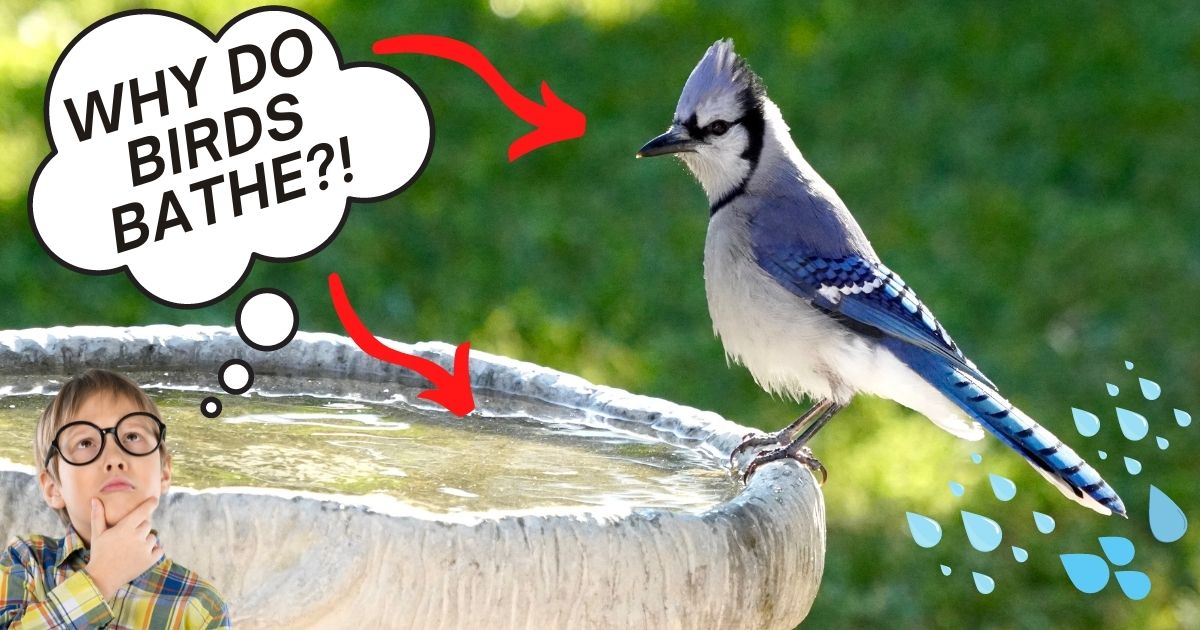Wouldn't it be great to look at your hummingbird feeder and “get to know your regulars?”
The hummingbird is one of the most popular birds in North America - as well as one of the cutest and tiniest. There are over 300 species flying around the globe but only 20 of those species visit us in North America and Canada. Out of that 20 - only a handful stay year round.
Each of these 20 species comes by their thousands to visit our hummingbird feeders and nectar flowers. Some look very similar - but if you look closely, you will find some interesting differences.
Here are 20 North American hummingbird species to spot and identify as they sip your nectar!
Looking for a hummingbird feeder? Click here to see one of our best-selling inventions!
1. Ruby-Throated Hummingbird (Archilochus colubris)
 |
 |
QUICK ID: Rich red gorget, white chest, green sides, black forked tail.
How can we not start with the most popular and commonest of hummingbirds!
You will probably see a lot of this little flyer at your bird feeder or speedily zipping from flower to flower. The Ruby-Throated Hummingbird’s gorget (the iridescent throat patch of male hummingbirds) is strawberry-red. It glows in the sun like a brilliant jewel contrasting with his greyish-white underparts. The female he woos is plainer, though she has a shine of her own with iridescent green contrasting with her white feathers.
Some gardens need more than one hummingbird feeder as they are filled with so many Ruby-Throated Hummingbirds! In addition, you might see them catch an insect from a spider’s web. Enjoy it all while it lasts, because come fall, these happy visitors will migrate down south to Central America. Some can make the entire migration trip in a single flight!
2. Anna’s Hummingbird (Calypte anna)
 |
 |
QUICK ID: Elongated shimmering red gorget, reddish-brown crown, white patch over the eye, short and straight bill.
This little creature stays with us year round and is usually found on the west coast, anywhere from Baja California to British Columbia. Occasionally they can be spotted in Arizona.
Not even 4 inches long and weighing about 0.1 ounces - you will immediately spot the male with his shimmering pink crown and iridescent gorget, shiny olive-green underparts and slightly greener upper-parts. Females have about the same coloring except they are paler on the underside and don’t have the gorget, but they boast some red or pink spotting on the throat.
If you have a hummingbird feeder, you can be sure they will sip from its nectar. The same goes for nectar flowers in your garden. If they nest in your yard, that’s an extra treat. You will get a whole colorful new family who will sip from your flowers and hummingbird feeders all day long.
3. Black-Chinned Hummingbird (Archilochus alexandri)
 |
 |
QUICK ID: Black gorget which can shimmer purple in the right angle, green upper-parts, grey under-parts, long, down-curved bill.
Very popular in the west, these little flyers arrive in the summer to breed in the mountains of Washington, Oregon, California and as far south as Texas.
The easiest way to identify the black-chinned hummingbird male is by his iridescent purple band at the bottom of a black gorget which contrasts beautifully with his white collar and white-greyish underparts. The female black-chinned hummingbirds have green upper-parts, white underparts and sometimes have a very pale streaking on the throat as well as white spots on their tail. Both males and females have unusually long bills.
Hang up a hummingbird bird feeder and you will have a western friend for life. They eat insects, even spiders and can sip nectar at a rate of 13-17 times per second. Other than bird feeders, black chinned hummingbirds are found in parks, on top of dead trees, gardens, mountains and anywhere around canyons or shady oaks near river areas.
4. Rufous Hummingbird (Selasphorus rufus)
 |
 |
QUICK ID: Males: bright rufous upper-parts, dark reddish gorget. Females: green upper-parts, spotted throat, paler rufous flanks.
Rufous means orange-reddish or rusty colored.
The Rufous Hummingbird is a summer breeder who flies along the Pacific coast from Washington, Oregon, Idaho, British Columbia and sometimes Alaska. Relative to their size, Rufous Hummingbirds make one of the longest migrations and can travel up to 4000 miles one way!
It is super easy to recognize the male Rufous Hummingbird: his shimmering orange plumage and iridescent rufous gorget above his white patch is a dead giveaway. Females are not as obvious but have that same rufous color along their flanks, with a greenish-brown back and a whitish belly. Sadly, Rufous Hummingbirds have been in decline since the 70’s and are now down to only 60% of their original numbers.
Rufous Hummingbirds feed on insects such as gnats and flies as well as the nectar from colorful tubular flowers and hummingbird feeders.
These little guys are pretty competitive around the feeders, so best to put a few out there and space them out. They are very aggressive and chase off any intruders, even larger hummingbirds or resident ones during migration.
5. Allen's Hummingbird (Selasphorus sasin)
 |
 |
QUICK ID: Orange underparts and flanks, red gorget, green back, thick white breast patches.
Here to confuse us is Allen’s Hummingbird, looking very similar to the Rufous Hummingbird. They inhabit a very small part of the coastal forest between California and Oregon but are relatively common in this limited range. They winter in Mexico and migrate as early as January up the Pacific Coast.
Males have iridescent rufous throats and orange bellies, tails, and eye patches, something the females lack. Both sexes have long thin bills and green backs.
So how do we spot the difference between Allen’s and Rufous Hummingbird? The Allen hummingbirds are much greener on their backs and heads, have more reddish-orange on their flanks and have narrow outer tail feathers. The Rufous and Allen female hummingbirds, on the other hand, look identical.
Allen hummingbirds are found in open woods and can usually be attracted to hummingbird feeders in your garden, especially in spring, as they are early migrators.
6. Broad-Tailed Hummingbird (Selasphorus platycercus)
 |
 |
QUICK ID: Rose-pink throat, green back and sides, greyish-white underparts. Females: Reddish-orange sides.
Broad-tailed Hummingbirds breed during the summer up in the meadows and open habitats of Idaho, Montana, Wyoming and southern California. They also breed in the mountains, up to 10,000 feet. As such high elevations can be extremely cold, the hummers have developed a way to slow down their heart rate and drop their body temperature to enter a state of torpor.
The first thing you will notice is that broad-tailed hummers look identical to the ruby-throated hummingbirds. But when you look more closely, you will see that the broad-tailed hummingbirds have a reddish-orange patch on their tails - something that ruby-throated hummers do not. The female broad-tails have a lighter reddish-orange coloring on their sides and throats which ruby-throated hummingbirds females don’t have.
In addition, broad-tailed males produce a much louder flapping sound of wings than the regular mild “humming” of other hummingbird wing beats.
In addition to the mountains and other open woodlands, broad-tailed hummingbirds love visiting nectar feeders. They also feed on insects and nectar from flowers such as larkspur, red columbine, sage and scarlet gilia.
7. Costa’s Hummingbird (Calypte costae)
 |
 |
QUICK ID: Small, plump, purple gorget, white eyebrow.
Down from the mountain peaks comes Costa's hummingbird, whose habitat is in the desert. These guys are year-round residents in California, Arizona and Nevada. They migrate for breeding between the Pacific Coast of Mexico in winter up to Arizona, southern Nevada, Utah, and California.
Costa’s hummingbirds stand out with a bright purple or pinkish shine that covers their crowns, gorgets and the sides of their throat. Females don’t have those bright colors but do have the same green upper-parts the males have, whitish underparts with some green along the flanks.
These small hummingbirds aren’t always found in urban areas, they prefer desert scrub, chaparral and deciduous forests.
However if you have a hummingbird feeder in your backyard, you might very well get them as visitors.
8. Green Violet-Ear, aka Mexican Violet-ear (Colibri thalassinus)
 |
 |
QUICK ID: Bluish-purple triangle by the ear, iridescent green plumage, dark blue tail with broad black band.
Though Mexican Violet-ears breed mainly in the forests of Mexico and Nicaragua as well as the mountains of Bolivia and Venezuela, in summer they can be spotted in southern Texas as well as Missouri, Michigan, North Carolina and various other states all the way up to Ontario.
The violet-ear is known for its blue or purple triangular ear patch amongst his iridescent green plumage. A wonderful detail to notice up close is that when they spread their bluish-green tails open, a purple-like wide stripe is visible. Females have the same colors but paler.
It is rare to see a violet-ear at your hummingbird feeder but not impossible! Once they do appear, like other hummingbirds, they can be aggressive to other flyers. So best to have a few hummingbird feeders, something for everyone. At the end of the day, you will have even more hummingbirds in your garden. Sounds like a party to me!
9. Blue-Throated Hummingbird aka Blue-Throated Mountain Gem (Lampornis clemenciae)
 |
 |
QUICK ID: Large, dark-blue throat, white stripe above eye, large, broad tail.
Meet the largest hummingbird who spends the summer in the US. He's about 4-4.7 inches long, weighing about 0.3 oz. He loves the mountains and canyons on the border of Mexico and the US, mainly Eastern Texas and Southeast Arizona. Though beautiful to spot, he is super aggressive to other hummingbirds, chasing them away from nectar sources.
His most unique feature is the jewel-like shimmering blue spots on his white throat which can be seen when the angle of light is just right. He has greyish underparts and greyish-green upperparts and white coloring on his tail.
His female counterpart looks the same except for the blue spots which she lacks.
Blue-throated hummingbirds are most frequently seen near the streams of mountain canyons where there are lots of nectar flowers. They also love hummingbird feeders - especially when flowers are scarce. They usually feed in the early morning and late afternoon to avoid the midday heat.
10. Calliope Hummingbird (Stellula calliope)
 |
 |
QUICK ID: Tiny, royal-pink gorget, green upper-parts, greyish-white underparts, small bill, short rounded tail.
Meet the smallest bird in North America, about 3 inches long, weighing no more than one-tenth of an ounce! It is for this reason that these tiny little gems feed on low-growing flowers, so as to avoid the aggression of bigger hummingbirds.
Calliopes were formerly considered the only member of the genus Stellula, but recent evidence suggests its genus is actually Selasphorus, meaning little star. Calliope (which means “beautiful voice”) was the Greek muse of music and dance.
Small but feisty, calliopes manage to fly more than 5,000 miles each year all the way from Mexico up as far as Canada and back. Despite their tiny size, they can defend their territory pretty well and even chase away Red-tailed Hawks! These hummers can survive in cold climates at high elevations around the Rockies, Canada and all the way to southern Mexico. In the summer, these guys nest in Southern British Columbia, Idaho, Nevada, Utah and California, Montana, Washington and Oregon.
If you live in one of these states, get your hummingbird feeders ready! They will definitely come to the party.
11. Violet-Crowned Hummingbird (Amazilia violiceps)
 |
 |
QUICK ID: Violet crown and sides of head, long red bill with black tip, brownish upper-parts, white underparts.
Up until 1959, no violet-crowned hummingbirds were spotted in the US but nowadays they are humming around the eastern border of Arizona and southern New Mexico.
When nectar flowers are not available, they will find sustenance by flying around the mid-level of tall trees, gulping down insects in mid-flight.
Violet-crowned hummingbirds are easy to identify by their bluish-purple crowns. These contrast beautifully with their snow-white underparts and throats as well as their grayish-green upperparts. But the biggest giveaway is their prominent red bill with its black tip. Both sexes look the same. The females, of course, just have duller plumage.
Violet-crowned hummingbirds generally migrate south in the winter but some may stay in backyards where hummingbird feeders are offered.
12. Magnificent Hummingbird aka Rivoli’s Hummingbird (Eugenes fulgens)
 |
 |
QUICK ID: Large hummingbird, long bill, dark green upper-parts, dark underparts. Females: lighter underparts, white spot behind eye.
These are the largest hummingbirds in North America and the most impressive looking - which is probably how they got their name: the Magnificent hummingbird. This majestic flyer can reach about 5-5.25 inches long and weigh up to 0.3 oz. In the summer they migrate north to nest in southeastern Arizona and southwestern New Mexico, occasionally western Texas. The way to recognize a Magnificent hummingbird is by the male’s dark plumage as well as his long, straight bill. Behind his eye is a distinct white spot. He has a dark olive-green body with an iridescent turquoise gorget as well as a shimmering violet crown. Females are, as always, the same but plainer, with green backs and grayish underparts.
Magnificents love pine-oak forests in mountainous regions but if you have a feeder in your garden, be sure they will pay you a visit. regions but if you have a feeder in your garden, be sure they will pay you a visit.
13. Lucifer Hummingbird (Calothorax lucifer)
 |
 |
QUICK ID: Long purple gorgets, green all over, curved bill.
Lucifer hummingbirds are a rare sighting in North America and as such are one of the most eagerly sought-after. If they reach our regions, it’s usually during the breeding season in west Texas, southeastern Arizona and southwestern New Mexico.
Unfortunately they scarcely visit hummingbird feeders but love the edges of desert canyons where they can feed on agave stalks, century plants and a desert shrub called the ocotillo plant.
Male Lucifers have striking iridescent purple throats and green upperparts and flanks. Their tails are dark and on close inspection you can see they are also forked. Females have green upperparts and light-brown underparts. An easy way to spot the female is by her gray streaked ear, like smoky eye shadow. Both sexes have long bills curving downward.
14. Broad-Billed Hummingbird (Cynanthus latirostris)
 |
 |
QUICK ID: Long, broad and jalapeno-red colored bill, emerald bluish-green body and dark bluish-black tail.
Broad-billed Hummingbirds are found mostly in the lowlands and arid habitats of central Mexico and its Pacific Coast. In summer, some migrate to the canyons of southern Arizona and New Mexico but others stay year round!
To confuse us further, Broad-bills look a little like Magnificent hummingbirds. They both have dark green and blue plumage, but it’s the red bill with the black tip that sets them apart. It broadens toward the end, hence their name.
Broad-bills are really beautiful. If you are lucky enough to spot them, they are mesmerizing to see with their striking red bills, emerald bodies and shimmering sapphire gorgets - very different to any other hummingbird. Females have bright green upperparts and gray underparts with a paler red bill. Though sizes are hard to tell with hummingbirds, the broadbills are much smaller than the magnificents.
Though broadbills are solitary, they can be aggressive at the feeder. And it is quite an experience to see them feed - they fan out their tails and wag them!
15. Berylline Hummingbird (Amazilia beryllina)
 |
 |
QUICK ID: dark green long gorget and crown, rufous-colored wings and tail, grey under-parts.
Ranging from Mexico to Honduras, Berylline hummingbirds roam in open areas where there are oak and pine trees, or cool streams and canyons. The first time they were sighted north of the US border was in 1964 as they were foraging for nectar in southeastern Arizona and western Texas. Some even stay year round!
Berylline hummingbirds can be as aggressive as the rest of their species. Hey, if you were that tiny, you’d do the same thing! it’s good to place an extra hummingbird feeder just for them or plant some nectar flowers - as they will take over and push other hummers away. But it is worth it as they are gorgeous to look at.
You will immediately notice the Berylline’s iridescent royal green head, throat and chest as well as darker muddy-red wings and tail. The lower abdomen is creamy-gray, and streaks of rufous in their tail. The bill is truly beautiful: red below and black above.
Berylline females are paler and a little smaller than the males. Their upper bills are black and the lower bill is more muddy-orange. Notice the soft three-noted chirp which sounds like a tiny trumpet.
16. White-Eared Hummingbird (Basilinna leucotis)
 |
 |
QUICK ID: White stripe behind eye, violet gorget and crown, short red bill with black tip, green upper-parts.
Though rare, white-eared hummingbirds have been spotted in the mountains of southeastern Arizona, southwestern New Mexico and western Texas since the 1890s. They migrate north for the breeding season all the way from Nicaragua and look for nectar in pine-oaks and evergreen pine forests. They can also be seen sipping nectar from flowers on the sides of the road.
White-eared hummingbirds have green backs and breasts, black heads as though wearing a black mask - and the most distinctive characteristic of both females and males: a white eyestripe. The male’s head and throat, if lit properly, flash in brilliant violets and greens. Males have a metallic turquoise green throat with violet patches on the face. Both have red beaks with black tips.
17. Buff-Bellied Hummingbird (Amazilia yucatanensis)
 |
 |
QUICK ID: Buff-colored belly, shimmering green gorget, rufous tail, dark wings, red bill with black tip.
This bird is medium-sized. The male’s slim bill is red with a darker tip. They have metallic olive green upper parts and creamy lower breasts. Their tail and plumage have a rufous colour and is slightly forked. Their gorget is a metallic golden green. The female has a dark upper bill, and is less colourful than the male.
Buff-belly hummers nest regularly in southernmost Texas and are the ambassadors for the Amazilia genus, a group of hummingbirds found all over the American tropics. In winter, the Buff-bellied Hummingbird will migrate short distances along the Gulf Coast along to Louisiana and Florida.
Semi-open habitats or woodland edges provide an ideal habitat and they will also visit backyards for flowers or nectar feeders. Small insects also make up some of their diet.
You can attract more Buff-bellied Hummingbirds with nectar feeders and red tubular flowers such as Turk’s cap and red salvia.
18. Xantu’s hummingbird (Basilinna xantusii)
 |
 |
QUICK ID: Long white line behind eye, green upper-parts, blackish-grey forehead and side of head, long red bill with a black tip.
Xantus’s hummingbird is a medium sized hummingbird named after the Hungarian zoologist John Xantus de Vesey. Like the rest of the hummingbirds, these guys are nectarivores (feed on nectar,) capable of hovering and flying in all directions, including backwards!
Though this is a Mexican species, he is rarely seen in the United States. One can get a glimpse of him in Baja California. Some made it further north - like Ventura CA, or even British Columbia! But they did not manage to nest there.
These little hummers prefer scrubby woodlands, mountainous pine-oak woods, desert scrub and if you live in the area and have a hummingbird feeder, you can be sure they will visit.
You will notice the white ear and think it is a white eared hummingbird. They are related but not the same! Both males and females have black masks with a bold and thick white ear-stripe painted by their eye. Their bills are red with black tips. Their tails are cinnamon colored. In the right light, the male’s black gorget will flash in a shimmering green. Females have reddish-buff underparts.
19. Cinnamon Hummingbird (Amazilia rutila)
 |
 |
QUICK ID: All underparts are cinnamon, upper-parts bronze and green, rufous tail.
Cinnamon Hummingbirds are bronze green on their backs. They are the only hummingbirds with cinnamon colored underparts from chin to tail. Their tails are reddish and their beaks have a black tip.
Usually Cinnamon Hummingbirds are found from northwestern Mexico down to Costa Rica but a few have ventured into southwestern United States. They inhabit forest edges of pine and oak and and also open scrubby areas, zipping around feeding on nectar and insects. Of course, if you live in the area and leave your hummingbird feeder is out, you will have cinnamon guests.
20. Plain-Capped Starthroat (Heliomaster constantii)
 |
 |
QUICK ID: Relatively large, extremely long bill, plain plumage, red gorget.
Plain-capped starthroats live in the dry forests of Mexico and Central America, but once in a while we are lucky to get a glimpse of this relatively big hummer in Arizona. So if you live in the area, get your hummingbird feeders out because they will visit! You will also see them fly-catching insects or enjoying the tube of a nectar flower.
Plain-capped starthroats prefer dry habitats, especially forest edges that streams run by, You will see him feeding mainly in the canopy.
The name of this species is a little misleading. Plain-capped is more like it. Starthroated, a little more dramatic than it really is as the throat color is very hard to see without perfect lighting angle. If the light isn’t right, the colors of the bird are dull.
So these guys are not as shiny and fancy as the rest of his species, but are still cute. He has brownish-green plumage and gray underparts. Plain-caps have long straight bills, striped faces with dark throats, and the white patch above the rump.He has a white whisker on his face and a white line behind the eyes. Also he has a white marking on his back and at the base of his wings. But when the sun shines on him in the perfect angle, you can see a small red patch on the base of his throat.
They prefer lower elevations, but are solitary birds and can be defensive in their territory.
So let's welcome our beloved hummers who as we speak are zipping from nectar-flower to hummingbird feeder. And now, you will be able to identify each one!
Learn how to attract even more hummers to your garden but first and foremost get a good hummingbird feeder. One that does't leak, is sturdy and doesn't attract bees. They are a joy to watch especially if they choose to nest in your garden because once they get used to your hummingbird feeder - they will come year round.
Happy Hummer Summer!




2 comments
Thomas Clarence
My son and I would like to get a bird feeder for our backyard this spring. It was helpful when you mentioned that some gardens need more than one hummingbird feeder. It seems like we are going to have to place at least two feeders in our backyard if we want to attract a lot of birds. https://thehummingbirdfeeder.com/hummingbird-feeders/
Charlene Beltz
Around supper time., I had a a small all black hummingbird at my scented geranium bloom. It had an kind of egg shaped red spot under its chin. I have never seen one ever like it. It wasn’t a moth. What kind was it???? Thankyou kindly!!!
Leave a comment
All comments are moderated before being published.
This site is protected by hCaptcha and the hCaptcha Privacy Policy and Terms of Service apply.